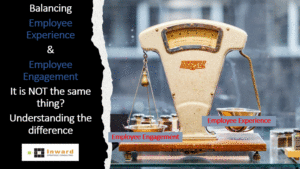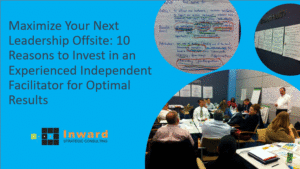The Future of Customer Experience (CX) and Its Transformative Impact on In-House Marketing and Creative Teams in Fortune 500 Companies: A Review from “Inward Strategic Consulting’s Perspective”
In this rapidly growing business era, Client Experience, or CX has emerged as a powerful differentiator for Fortune 500 agencies. As businesses increasingly recognize the crucial function of CX in driving
- customer loyalty,
- differentiation, and
- revenue growth,
the future of CX holds immense promise.
In this evaluation, we discover the insights provided in the ANA overview written by Sophy Regelous to provide Inward Strategic Consulting’s perspective. It delves into the transformative impact of CX and EX on in-residence advertising and innovative teams within Fortune 500 businesses.
In the ever-evolving landscape of enterprise and innovation, an incredible transformation is underway. One that transcends the conventional boundaries of CX and EX. This transformation goes by a profound and unifying name: “Human Experience.” It’s critical to understand that the final goal is the convergence of CX and EX to create a seamless and enriching Human Experience.
CX as a Competitive Differentiator
The Deloitte 2023 “Global Contact Center Survey” reveals a staggering statistic. According to this, 62% of Fortune 500 companies view CX as a competitive differentiator.
- This recognition has led these companies to prioritize substantial investments in technology, talent, and process enhancements. The aim is to improve the customer journey.
- This is a significant shift in the business landscape. It signals the vital role that marketing and creative teams within these organizations will play in shaping the future of CX.
The Role of Data in Shaping CX
One of the primary drivers of CX enhancement is the usage of data-driven insights. Marketing teams rely on consumer statistics to understand their needs and preferences. This approach permits them to craft targeted campaigns and engaging content. As stated in Gartner’s “Leadership Vision for 2022,” understanding how data, people, and technology intersect to inform decision-making is turning into a source of differentiation and survival.
In this data-driven era, marketing and creative teams are set to rely heavily on consumer data to
- make knowledgeable decisions,
- align advertising techniques with consumer expectancies, and
- enhance personalization efforts.
However, while data-driven insights are critical for optimizing campaigns, creative departments may face challenges in finding the proper balance between creativity and data.
Challenges for Marketing and Creative Teams
Meeting and exceeding rising customer expectations while battling accelerated opposition is a colossal challenge for marketing departments. Staying updated on rising tendencies, technology, and customer preferences is vital to delivering innovative and relevant experiences. Additionally, with the integration of omnichannel marketing, ensuring a steady brand experience and messaging throughout multiple channels may be complicated.
On the other side, in-house creative departments face the task of meeting the growing demands for customer-centric content and campaigns. This creative team has to stay informed about rapidly evolving customer expectancies driven by advancements in technology and shifts in consumer behavior. This is to create content that resonates with customers and meets their needs.
The Employee Experience Factor
While plenty of focus is placed on enhancing the customer experience, it is equally crucial to consider the effect of the EX. In fact, the alignment of employees and CE is a necessity. Employees are the face of the organization. T Their level of engagement, satisfaction, and alignment with the agency’s values directly affects the quality of the CX.
When personnel are engaged, stimulated, and well-equipped, they’re more likely to deliver excellent customer support and encompass the brand’s promise. Conversely, disengaged or dissatisfied employees can inadvertently lead to subpar customer interactions. Therefore, the employee experience should not be viewed in isolation; it’s an integral part of the broader CX atmosphere.
Building a Culture of Continuous Learning
To meet these increasing needs for CX, creative departments must cultivate a lifestyle of continuous learning and innovation. The pressure to provide quality content and campaigns within tight timelines can lead to improved workloads and potential burnout. Moreover, customer experiences span diverse digital and physical interactions. This necessitates seamless integration throughout those channels.
As technology evolves unexpectedly, creative departments must keep pace with emerging tools, platforms, and design strategies. This often requires upskilling and expanding the team’s know-how to effectively leverage technology for enhanced customer experiences. Budget constraints can pose extra challenges, making it important for creative teams to discover innovative solutions with limited assets.
Cross-Functional Collaboration
Customer experience is a cross-functional effort. It requires collaboration and alignment among creative, marketing, customer service, and different departments. Establishing effective communication and collaboration channels can be a challenge. Especially in larger businesses. However, these teams need to work in harmony to deliver a consistent and exceptional client journey.
The Role of Emerging Technologies
The CX enterprise is constantly evolving. In this, emerging technologies like AI and ML play a significant role. As early as 2019, Gartner expected that AI-driven personalization could boost profits up to 16% BY 2024. In-house teams ought to harness the power of these technologies
- to automate workflows,
- gather real-time statistics insights, and
- deliver hyper-personalized experiences to clients.
Summing It All Up as “Human Experience”
In the grand tapestry of commercial enterprise, the threads of Customer Experience (CX) and Employee Experience (EX) are intimately interwoven. The future of CX isn’t always simply about delivering exceptional service to clients; it is similarly about empowering and engaging personnel to be the champions of this mission. By recognizing that these two facets—consumer and employee—are intrinsically linked, companies can birth a “Human Experience” that transcends the sum of its parts.
In the world of “Human Experience,” data-driven insights serve as the compass. The role of this compass is to guide both marketing and creative teams to create content material and campaigns. These materials resonate with customers and cater to their evolving needs. Challenges that were once regarded as impossible become opportunities for growth and innovation. A culture of continuous learning becomes the
- bedrock of both personal and professional improvement,
- nurturing collaboration, and
- facilitating the alignment of consumer-centric and employee-centric values.
“Human Experience” recognizes that personnel are not simply cogs in the corporate machinery. But they are the heart and soul of an enterprise. Engaged and satisfied employees become ambassadors of the brand. They deliver exceptional customer service and fulfill the agency’s mission. When the consumer and worker reports align seamlessly, it fosters a sense of purpose and unity that transcends the transactional nature of business.
Moreover, “Human Experience” embraces emerging technologies, such as AI and machine learning, not as standalone solutions but as tools that enhance both customer interactions and employee productivity. It recognizes that technology should amplify human capabilities and not replace them.
As we navigate the complex pathways of the future, the “Human Experience” becomes the guiding light. It illuminates a holistic approach wherein clients and employees are not separate entities but essential components of a shared adventure. It’s a journey that recognizes that the sum of a positive customer experience and a thriving employee experience is greater than their contributions. It’s a journey that reminds us that, in the long run, it is the human contact—the empathy, the creativity, and the determination—that forms the cornerstone of lasting success in the CX era.
In this transformative era, the organizations that master the art of shaping the “Human Experience” will be the ones to lead the way It is not just in customer satisfaction and revenue growth, but in building a more connected, compassionate, and prosperous future for all.
Strategies for Success
To overcome these challenges and seize the opportunities presented by the future of CX and EX, and now “HUMAN EXPERIENCE” both marketing and creative departments must adopt several key strategies:
- Continuous Learning and Innovation: Invest in ongoing training to
- stay updated with industry trends,
- nurture a collaborative work environment, and
- utilize project management tools to streamline workflows.
- Resource Optimization: Find innovative solutions to meet increasing demands within budget constraints through
- technology,
- talent acquisition, or
- process enhancements.
- Cross-functional collaboration: Foster effective communique between marketing, creative, and different departments. By doing so, you may make sure an unbroken customer experience.
- Embrace Emerging Technologies: Embrace Emerging Technologies: Embrace AI, ML, and different emerging technologies. This is to automate procedures, gather insights, and deliver customized reviews.
Conclusion
The future of customer experience holds great promise. Its impact on in-house marketing and creative teams in Fortune 500 companies is set to be transformative. CX becomes a key driver of differentiation and competitive advantage. Hence, marketing, and creative teams will be at the forefront of designing and delivering exceptional experiences.
these teams can play a crucial role in shaping the future success of their organizations in the CX era. They do so by
- embracing data-driven insights,
- building a culture of continuous learning, and
- overcoming challenges through innovation and collaboration.
The journey ahead may be challenging. But with the right strategies and a customer-centric approach, these teams can thrive in the evolving landscape of customer experience.

































